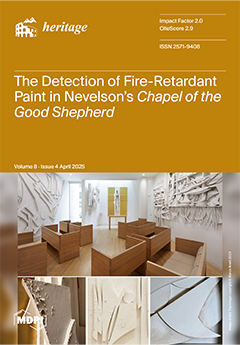Open AccessArticle
Mycenaean Vitreous Artifacts: Overcoming Taxonomy Hurdles via Macro-XRF Analysis
by
Artemios Oikonomou, Maria Kaparou, Anastasios Asvestas, Kalliopi Tsampa, Ourania Kordali, Konstantinos Nikolentzos, Katia Manteli, Aikaterini Voutsa, Georgianna Moraitou, Dimitrios F. Anagnostopoulos and Andreas G. Karydas
Viewed by 1426
Abstract
Mycenaean glass artifacts, such as beads and relief plaques, are highly susceptible to degradation, which can significantly modify their visual attributes and pose classification challenges. Corrosion on glass and faience artifacts has often led to misinterpretation, since the visual manifestations of degradation can
[...] Read more.
Mycenaean glass artifacts, such as beads and relief plaques, are highly susceptible to degradation, which can significantly modify their visual attributes and pose classification challenges. Corrosion on glass and faience artifacts has often led to misinterpretation, since the visual manifestations of degradation can be similar for both materials, impacting research conclusions. This paper presents a segment of a broader study conducted within the Myc-MVP project, utilizing advanced scientific methods to analyze the compositional changes in corroded vitreous artifacts. Through Macro-X-ray Fluorescence (MA-XRF) and LED microscopy, we aim to understand the correlation between compositional alterations and visual degradation manifestations. The use of MA- XRF was particularly crucial for non-destructively mapping the elemental distribution over large surfaces, allowing for a more comprehensive analysis of corrosion patterns. The results presented in this study are from a subset of artifacts examined using MA- XRF, highlighting critical insights into the spatial compositional shifts that contribute to visible deterioration. This paper discusses the first real-life contribution of Macro X-ray Fluorescence (MA-XRF) imaging to mapping the spatial compositional changes that occur when Mycenaean vitreous materials undergo degradation, yielding visible deterioration. MA-XRF scanning offers a fully non-invasive and non-destructive method for recording compositional data across the entire surface of an object. The results can be visualized as distribution images, which are more accessible and interpretable for a broader audience compared to the spectra generated by traditional spectrometric techniques. These findings aspire to inform strategies for the accurate classification, effective management, appropriate conservation treatment, and long-term preservation of vitreous artifacts.
Full article
►▼
Show Figures





